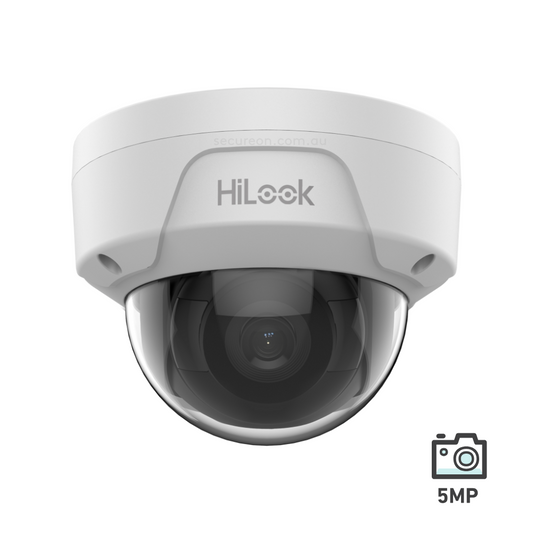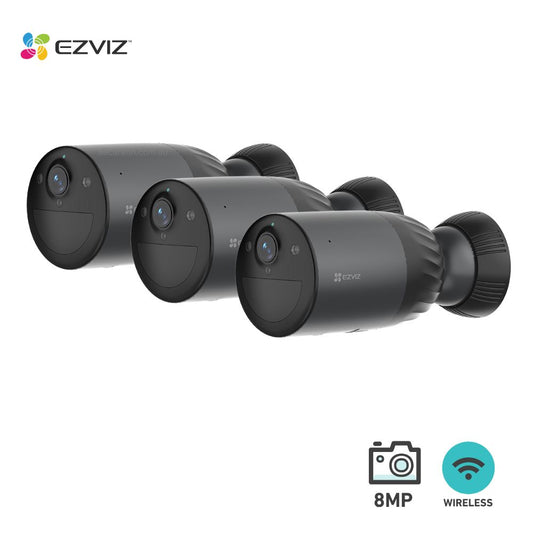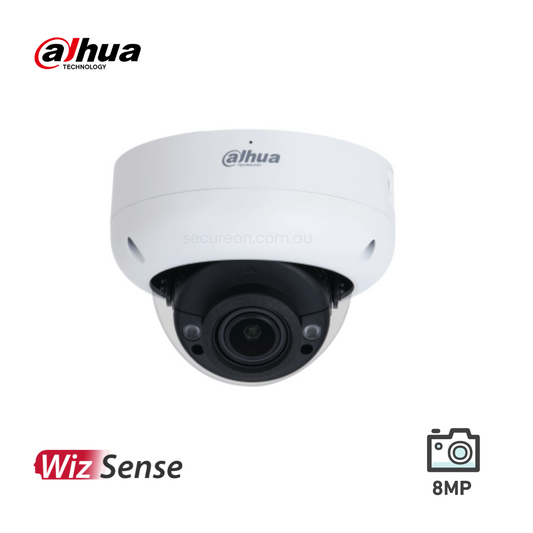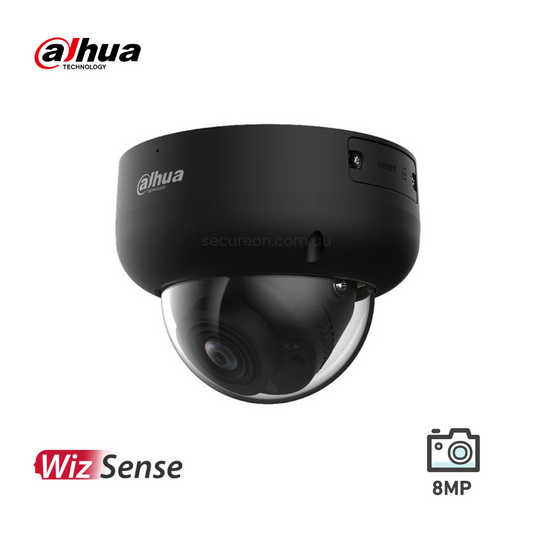- 10
- 15
- 20
- 25
- 30
- 50
- Featured
- Best selling
- Alphabetically, A-Z
- Alphabetically, Z-A
- Price, low to high
- Price, high to low
- Date, old to new
- Date, new to old
Sort by:
- Featured
- Best selling
- Alphabetically, A-Z
- Alphabetically, Z-A
- Price, low to high
- Price, high to low
- Date, old to new
- Date, new to old
-
Dahua 8MP 2.8mm WizSense Starlight SMD 4.0 Dome Camera DH-IPC-HDBW3866EP-AS-AUS
Launched by Dahua Technology, WizSense is a series of AI products and solutions that adopt independent AI chip and deep learning algorithm. It focuses on human and vehicle with high accuracy, enabling users to fast act on defined targets. Based on Dahua's advanced technologies,...- $219inc. GST
$261- $219inc. GST
- Unit price
- / per
Save $42View details -
Dahua 8MP IR Vari-focal Dome WizSense Network Camera DH-IPC-HDBW3866RP-ZAS-AUS - White
This camera replaced IPC-HDBW3841R-ZAS and DH-IPC-HDBW5631RP-ZE-27135. Key Features 8MP 1/2.8' CMOS image sensor, excellent low luminance performance and high definition of images. Outputs max. 8MP (3840 × 2160) @25/30 fps. H.265 codec, high compression rate, ultra-low bit rate. Built-in IR LED, max. IR distance:...- $367inc. GST
$436- $367inc. GST
- Unit price
- / per
Save $69-
White
-
Black
View details -
Dahua 4MP Dome Motorised Camera WizSense Starlight SMD 4.0 DH-IPC-HDBW3466RP-ZAS-AUS
Launched by Dahua Technology, WizSense is a series of AI products and solutions that adopt independent AI chips and deep learning algorithms. It focuses on humans and vehicles with high accuracy, enabling users to fast act on defined targets. Based on Dahua's advanced technologies,...- $267inc. GST
$318- $267inc. GST
- Unit price
- / per
Save $51View details -
Dahua 4MP Dome Camera WizMind DH-IPC-HDBW5442EP-ZE-2712
WizMind Series - Designed for project-oriented products. Equipped with a deep learning algorithm allowing advanced AI face recognition with attribute filtering by gender, age, glasses, mask, beards and emotional expressions such as anger. (compatible with AI Series NVR’s) It provides advanced AI for people...- $723inc. GST
$0- $723inc. GST
- Unit price
- / per
Save $-723View details -
Dahua 4MP Dome Camera 2.8mm WizSense Starlight DH-IPC-HDBW3466EP-AS-AUS
Launched by Dahua Technology, WizSense is a series of wide-range AI products and solutions that adopt independent AI chips and deep learning algorithms. It can recognize humans and vehicles in an image with high accuracy, enabling users to focus on real targets. WizSense focuses...- $153inc. GST
$200- $153inc. GST
- Unit price
- / per
Save $47View details -
Dahua 4MP Wide Angle Fixed Dome WizSense Network Camera DH-IPC-HDBW3466R-AS-P
Introducing the Dahua DH-IPC-HDBW5442E-ZE 4MP Pro AI IR Vari-focal Dome Network Camera, a high-quality surveillance solution with advanced features. It offers clear 4MP video, WDR, Day/Night, and 3D DNR for optimal image quality. The camera supports audio in/out, alarm in/out, and has a maximum...- $207inc. GST
$247- $207inc. GST
- Unit price
- / per
Save $40View details -
Dahua 4MP Pro AI IR Vari-focal Dome Network Camera DH-IPC-HDBW5442E-ZE
Introducing the Dahua DH-IPC-HDBW5442E-ZE 4MP Pro AI IR Vari-focal Dome Network Camera, a high-quality surveillance solution with advanced features. It offers clear 4MP video, WDR, Day/Night, and 3D DNR for optimal image quality. The camera supports audio in/out, alarm in/out, and has a maximum...- $723inc. GST
- $723inc. GST
- Unit price
- / per
View details -
Dahua 6MP IR Vari-focal Dome WizSense Network Camera DH-IPC-HDBW3666RP-ZAS-AUS
The DH-IPC-HDBW3666RP-ZAS-AUS Network Camera is a part of the WizSense 3 Series that greatly saves on bandwidth and storage space through its AI Coding technology. Driven by its advanced deep learning algorithms, the camera supports intelligent functions such as perimeter protection, smart motion detection...- $343inc. GST
$355- $343inc. GST
- Unit price
- / per
Save $12View details -
Dahua 5MP IR Vari-focal Dome Motorised WizSense Network Camera DH-IPC-HDBW3541RP-ZAS-27135
Dahua DH-IPC-HDBW3541RP-ZAS-27135 is a part of the WizSense 3 Series which supports intelligent function such as perimeter protection and smart motion detection. It also adopts Starlight technology that provides a better image effect in the condition of low illuminance. Features include SMD Plus, Smart H.265+...- $283inc. GST
$326- $283inc. GST
- Unit price
- / per
Save $43View details
The Dome / Vandal Dome cameras - named after its shape and typically used for indoor security systems - are vandal-resistant (IK10) and great for high-risk applications.
The dome shape of the cameras allows them to be reasonably inconspicuous as it is difficult to tell the direction these cameras are facing; however, they are still visible to the eyes.
A dome camera is the best kind of CCTV camera for restaurants, shops, casinos and hotels. This is because their design allows you to easily monitor a wider angle at your business premises.
Since these cameras are installed on the ceiling of a room, they are usually vandal proof as well. And it is worth noting that some dome cameras are also designed with infrared illuminators, enabling them to capture videos even in low light conditions.
Advantages of a dome camera
Very hard to break
The cover that protects the camera is usually made of polycarbonate and very difficult to break. Great for locations that are within reach.
The direction of the face is non-visible
Great for retail applications, the Vandal Dome Camera has a non-reflective cover that ensures the face of the camera is hidden.
Wall or ceiling mount options
Just like the turret dome, Vandal Dome can be mounted on wall or ceiling. You may even choose a wall mount bracket to cover the surveillance area better.
Unsure if a dome camera is a right solution for your security setup? Our friendly team of security consultants is available to you on call 1300 888 767.




























